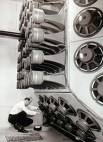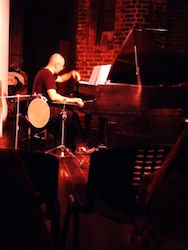
 |
(Piano) Technique The study of technique is a mean to free us to achieve clarity of exposition of a poetic idea. The pianist, you, at all levels from beginner to advanced, is the person that educates her fingers, the hand, the arm, the body, the whole apparatus, to learn how to execute precise, pourposeful, and functional movements. When the body has learned the "lesson" it will not need direct control, but it will take charge giving us freedom to concentrate on the final goal: the music. What first is rational and scientific and planned, will become natural, instinctive and free. How to gain a secure technique? There are many ways to achieve technical security but a sure and efficacious one is to play slowly, with strength and relaxation, and creatively and with concentration. Imagination is the key: one needs to learn how to imagine the realization of a piece, and how to make it happen in the translation between thought and actuality. Perhaphs in the exercise of these qualities, slowness, relaxed strength, concentrated creativity, are the roots for becoming a master at an instrument. Obviously a web page is not a place where to learn the piano: a practical example at the piano is sometimes worth a thousands words. However in the future additional pages will include short discussions and suggestions of main piano technical problems including: musical idea, posture, free fall, articulation, staccato, legato, octaves, trills. Metronome. A blind use of the metronome, resulting in notes being played all equal, can remove any sense of flexibility and beauty from music: the sense of rithm must be generated from within not by an external device. However the metronome is valuable and can be used to establish and reinforce our natural sense of rithm. For the best example of a wonderful musical pulse: listen to Pablo Casals playing the first J.S. Bach Cello Suite: within a measure there is a wonderful extent of rithmic flexibility, still! one can put a metronome marking the beginning of each measure (not beats within the measure) and marvel at the accuracy of this longer pulse. Scales I practise my scales doing so with a metronome speed of 80-100 using the 1=>6=>1 notes/beat sequence reported above. When I play 1 note/beat I do one octave, at 2 two octaves, all the way to 5 octaves for 5 notes/beat. Not all scales have 6 octaves on the keyboard so I only do three octaves at that speed. It takes few minutes to go thrugh all the minor and major scales playing in the descending or ascending circle of the fifths with added minor. (That is C - a - F - d - B-flat - g - etc, or alternatively C - e - G - b - D - etc).

![]() Slow practise is important because our mind has to learn the "lesson": we are slowing motion down so that the mind can grasp all the necessary details and not be confused by otherwise unavoidable mistakes. We slow down as much as necessary to mentally grasp and avoid mistakes.
Slow practise is important because our mind has to learn the "lesson": we are slowing motion down so that the mind can grasp all the necessary details and not be confused by otherwise unavoidable mistakes. We slow down as much as necessary to mentally grasp and avoid mistakes.![]() Strength and Relaxation go together. Strength means producing a solid sound, with the fingers going deep into the keys (but without applying unnecessary pressure after the key is pressed). Relaxation means to be able to feel all the parts of the body (the joints at the wrist, elbow, shoulder) always constantly free of tension, without any muscle contraction, ready to move as desired.
Strength and Relaxation go together. Strength means producing a solid sound, with the fingers going deep into the keys (but without applying unnecessary pressure after the key is pressed). Relaxation means to be able to feel all the parts of the body (the joints at the wrist, elbow, shoulder) always constantly free of tension, without any muscle contraction, ready to move as desired.![]() Creatively here means trying different sound intensities, different phrasings, articulations ... different musical ideas. Creative practise, as opposed to mindless repetition, is the best mean to retain the all important concentration. We simply get bored and loose concentration when asked to repeat an identical task hundreds times, and then we do mistakes and we confuse our mind. Creative variety not only explores an universe of poetic possibilities, but it guarantees that practise time is well spent and that we keep our mind engaged and interested.
Creatively here means trying different sound intensities, different phrasings, articulations ... different musical ideas. Creative practise, as opposed to mindless repetition, is the best mean to retain the all important concentration. We simply get bored and loose concentration when asked to repeat an identical task hundreds times, and then we do mistakes and we confuse our mind. Creative variety not only explores an universe of poetic possibilities, but it guarantees that practise time is well spent and that we keep our mind engaged and interested.
![]() Inner conductor. Don't think that the metronome is an external device that tells you what to do. "Conduct" the metronome instead. Put the metronome at a very confortable speed (around 60, close to your hear-beat) and beat your hand on a surface: imagine that is your hand that is causing the metronome to tick. The same can be done at the keyboard: imagine that it is the end of the downstroke, the key hitting the keybed, that sends the impulse to the metronome to tick. The purpose here is to establish a mental habit that makes you think of conducting, instead of having a machine ordering you around.
Inner conductor. Don't think that the metronome is an external device that tells you what to do. "Conduct" the metronome instead. Put the metronome at a very confortable speed (around 60, close to your hear-beat) and beat your hand on a surface: imagine that is your hand that is causing the metronome to tick. The same can be done at the keyboard: imagine that it is the end of the downstroke, the key hitting the keybed, that sends the impulse to the metronome to tick. The purpose here is to establish a mental habit that makes you think of conducting, instead of having a machine ordering you around. ![]() Natural sense of pulse. Pay triplets (or quadruplets) for each beat. Don't play the notes all at the same speed. The notes after the beat are a bit faster so that you have a short extra interval of time to "prepare" the upcoming beat. The goal is to catch (conduct) the metronome beat so accurately that your next note almost obliterates it. This achieves two effects: first it develops a steady sense of pulse, second it makes the musical space between the metronome beats come alive. Here speed is absolutely not important, you can do this exercise at very slow speed: accuracy and listening is important.
Natural sense of pulse. Pay triplets (or quadruplets) for each beat. Don't play the notes all at the same speed. The notes after the beat are a bit faster so that you have a short extra interval of time to "prepare" the upcoming beat. The goal is to catch (conduct) the metronome beat so accurately that your next note almost obliterates it. This achieves two effects: first it develops a steady sense of pulse, second it makes the musical space between the metronome beats come alive. Here speed is absolutely not important, you can do this exercise at very slow speed: accuracy and listening is important. ![]() And finally there is the use of the metronome to play different groupings of notes. Simply, with the metronome at a constant speed play an exercise (scales are perfect, see below) with 1, 2, 3, 4, 5, and 6 notes/beat and then 5, 4, 3, 2, and 1 (1=>6=>1).
And finally there is the use of the metronome to play different groupings of notes. Simply, with the metronome at a constant speed play an exercise (scales are perfect, see below) with 1, 2, 3, 4, 5, and 6 notes/beat and then 5, 4, 3, 2, and 1 (1=>6=>1).
 |
||
|